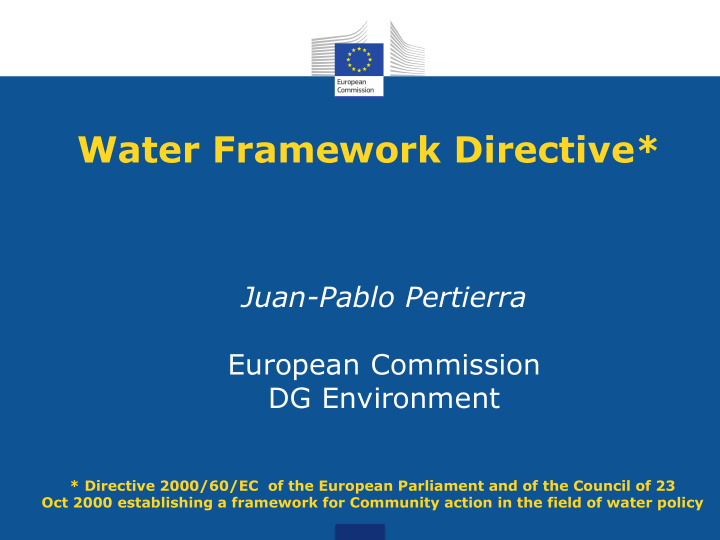



Water Framework Directive* Juan-Pablo Pertierra European Commission DG Environment * Directive 2000/60/EC of the European Parliament and of the Council of 23 Oct 2000 establishing a framework for Community action in the field of water policy
Scope and objectives of the Water Framework Directive • Scope – Protecting all water bodies, including transitional waters and coastal waters. – Covering all impacts on waters. • Objectives – Protect and enhance water bodies – No deterioration – Achievement of good status / potential by December 2015 • Tools – 2nd River Basin Management Plans and Programmes of Measures by December 2015 – Existing legislation: habitats, nitrates, The River Basin Concept – urban waste water, marine strategy, etc – Public participation integrated river basin management 2 water.europa.eu water.europa.eu
River Basins Districts • Diversity of river basins • Many transboundary rivers • RB Management Plans water.europa.eu water.europa.eu
Diversity of water uses, pressures and impacts on WB Agriculture Drinking water Tourism Flood protection Industry Nature protection Navigation & hydropower Waste Water water.europa.eu
Environmental objectives: "Good ecological & chemical status" • Biological elements • Composition and abundance of aquatic flora • Composition and abundance of benthic invertebrate fauna • Composition, abundance and age structure of fish fauna • Hydro morphological elements • Hydrological regime • River continuity • Morphological conditions • Physico-chemical elements • General (oxygenation, nutrients, salinity, etc.) 5 • Specific pollutants (synthetic and non-synthetic)
Ecological Status (Annex V) Classes minimal { No or HIGH Slight { GOOD Intercalibration Moderate { MODERATE Major { POOR Severe { BAD Courtesy Peter Pollard, Scottish Environment Protection Agency
Article 4 (Exceptions) • WFD allows for deterioration by new anthropogenic modifications under strict conditions; • Project is of overriding public interest/outweighing water protection benefits • No better environmental options • All mitigation measures are taken • Project and reasons are reported in RB Management Plan • Other water bodies within same RBD are not impacted • A water body can be designated as heavily modified and good ecological potential can be achieved instead of GES.
Hydropower Generation Structural barrier Risk of fish Possible alterations to the movement entrainment in of aquatic fauna turbine intakes Altered Altered water sediment level fluctuation dynamics in reservoir Altered Altered flow structure of regime in reservoir shore downstream zone habitats river Altered physico- Altered structure and Altered physico- chemical condition of bed, chemical conditions conditions in banks & riparian zone in downstream river reservoir in downstream river stretches
Good Ecological Potential • Objective set only for HMWB following Art 4.3 GEP represents best possible ecological status • considering the modification Physical modifications may impact some quality • elements, not all. No impact GES applies Mitigation measures should be included into MP in • order to restore the WB to the best possible ecological condition
Mitigation measures for hydropower generation Approaches for good practice include: Restoration of biological continuity (upstream and downstream) for securing migration and accessibility to habitats Ecologically acceptable flow conditions downstream of diversion plants Mitigation of the effects of hydro-peaking Re-creation and improvement of habitat structures
Mitigation Measures - Examples Restoration biological continuity Two types of functioning fish passes. The more natural-like bypass channel (bottom) provides additional spawning ground. Technical and nature-like bypass channel for fish migration next to hydropower dams.
Mitigation Measures - Examples Ecologically acceptable flow requirements Assuring ecologically acceptable flow requirements is essential for aquatic habitats but also continuity. No water – No life. Negative example for a diversion flow hydropower station – downstream river stretch has fallen completely dry.
Mitigation Measures - Examples Hydro-peaking Mitigation options against hydro- peaking are often limited and can involve high costs (loss of peak- load capacity and designated function). However, examples for successful implementation of mitigation measures exist (e.g. coordination between HP’s, conversion into pump-storage power stations, etc.). Hydro-peaking: The same river stretch during the flush event (top) and during downsurge (bottom).
Few remarks after 1 st RBMP cycle • Need to ensure ecological continuity for species and habitats types of Community interest • Researchers and industry to look into technical solutions to mitigate the impact of projects (dams, hydropower plants) including fish-friendly turbines, fish ladders, etc. • Consider other significant pressures which could affect the good ecological or potential status, such as fisheries and navigation.
Few recommendations for 2 nd RBMPs • Improve assessment of hydro morphological pressures in relation to BQEs, particularly for the upper course of the Danube (fish) • For existing infrastructure – restoration measures (hydropower permits, establishment of fish passes, etc) • Tackle the fishing pressure (professional & recreational) and poaching, particularly in the lower course of the Danube.
More information DG ENV webpages: http://ec.europa.eu/environment/water/water-framework/index_en.html Thank you very much!
Recommend
More recommend